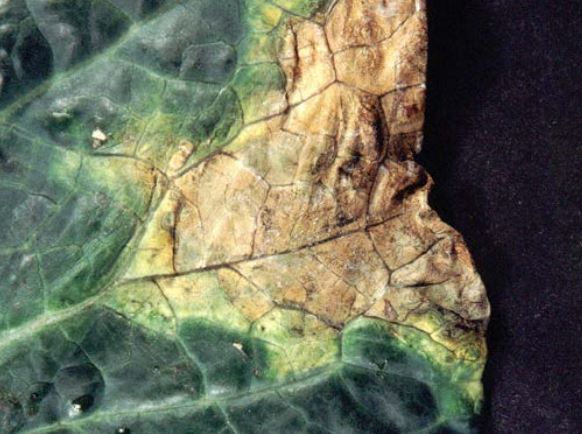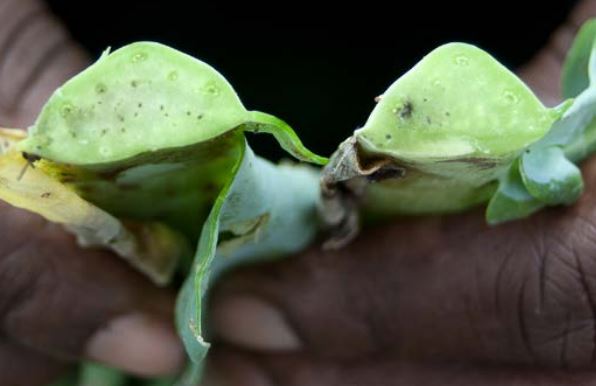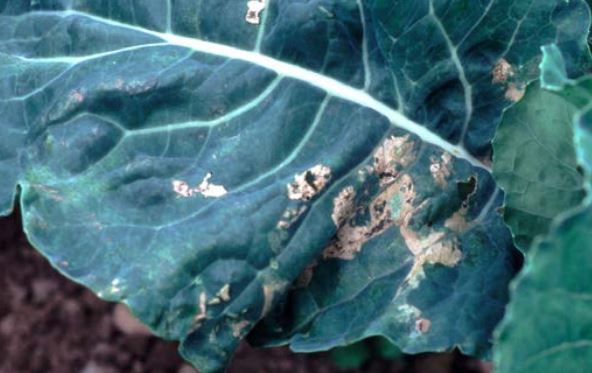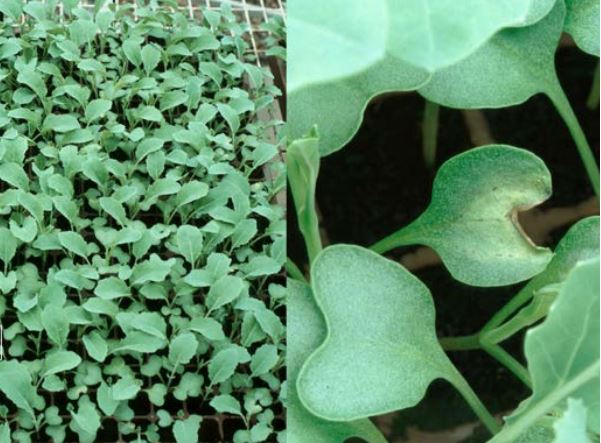Please click here to access the main AHDB website and other sectors.
- Home
- Knowledge library
- Black rot of brassicas: symptoms and biology
Black rot of brassicas: symptoms and biology
This page provides details of the symptoms and biology of black rot of brassicas caused by Xanthomonas campestris pv. campestris
This information was last updated in 2023.
Symptoms
In the field
The most obvious and characteristic leaf symptoms in the field are yellow ‘V-shaped’ lesions with blackened veins that develop from the edges of the leaves (Figures 1 and 2). As the lesions enlarge they become necrotic, pale brown and dry, due to blocking of the vascular system.
 S J Roberts
S J Roberts
Figure 1. Typical field symptoms of black rot in a winter cabbage crop - yellow V-shaped lesions developing from the leaf edges.
 S J Roberts
S J Roberts
Figure 2. Close-up of a V-shaped lesion.
Systemic infection can also be seen as blackened vascular bundles (Figure 3) in the leaf petiole or main stem, and result in (often one-sided) wilting. Severe infections can result in stunted or dead plants.
Infected leaves are lost prematurely and this can occur at relatively low levels of infection. It is a particular problem in winter cauliflowers, when wrapper leaves are lost exposing the curd so that it becomes unmarketable. Secondary soft rots may also occur, exacerbating the symptoms in cabbage and cauliflower.
Less commonly the disease may be seen as dark water-soaked spots or larger areas on leaves which may progress to become systemic, with the typical symptoms described above or papery 'blight' symptoms (Figure 4). However, water-soaked leaf spots can also be caused by other bacterial pathogens such as X. campestris pv. raphani or Pseudomonas syringae pv. maculicola.
 S J Roberts
S J Roberts
Figure 3. Blackened major veins on a cabbage leaf.
 S J Roberts
S J Roberts
Figure 4. Papery blight symptoms on cauliflower.
In seedlings and transplants
Initial symptoms can be difficult to spot in seedlings and transplants. Infected cotyledons may have slight yellowing and necrosis (Figure 5), but often shrivel-up completely and drop off before they are noticed. Typical lesions may develop on young leaves, but transplants are often planted out before they are obvious or have had time to develop.
 S J Roberts
S J Roberts
Figure 5. First symptoms on cotyledons in transplants are difficult to spot.
The pathogen
The disease is caused by the rod-shaped, motile, Gram-negative bacterium Xanthomonas campestris pv. campestris (Xcc). All cultivated brassicas, radish, cruciferous weeds and a number of ornamental species can be infected. However, the pathovar is divided into a number of distinct races, which have different host ranges. There are currently at least nine races; these are differentiated by their pathogenicity on a number of differential Brassica species and cultivars.
Worldwide, Races 1 and 4 are the predominant races in vegetable brassicas. The apparent dominance of these races may be a reflection of (a lack of) resistance to these races in the hosts.
The closely-related bacterium Xanthomonas campestris pv. raphani causes localised leaf spots, but does not invade the vascular system. It can be present alongside Xcc.
Infection and disease management
Xanthomonas bacteria can survive on plant surfaces and enter plant tissues through through natural openings or wounds. In brassicas most infection occurs via hydathodes (pores at the edges of leaves) and is the reason for the development of the the typical V-shaped lesions as the bacteria progress along the vascular system. However, infection can also occur via stomata, or damage caused by hail, machinery or birds/animals.
Once inside the plant, bacteria multiply and symptoms develop when populations reach high levels, and as the vascular system becomes blocked. The speed at which symptoms become apparent depends on a range of factors, especially temperature. At optimum temperatures (~25°C), symptoms generally take 10 to 14 days to appear following infection, but may take much longer at lower temperatures.
A single infected leaf may contain more than a billion bacteria (109), but even before symptoms become visible there may be as many as a million bacteria (106) in a single lesion. These can be released rapidly once a leaf becomes wet. Thus symptomless plants can be highly infectious well before symptoms are apparent.
Epidemiology
Seeds
Seeds are the primary source of inoculum and means of long-distance dissemination. Although crop debris and cruciferous weeds can potentially act as sources of inoculum, almost all significant field outbreaks of disease have been associated with seed infection.
The disease has often associated with certain varieties, and growers have usually assumed this is because the variety is more susceptible, when in fact it may be because the seed stocks of the variety are more likely to be infected.
Spread
Most local (within-crop) spread occurs by water-splash, irrigation, or wind-driven rain, but anything that moves within and between crops (people, animals, insects, equipment, machinery) can potentially spread the bacterium, especially in wet conditions. It is important to be aware that considerable numbers of bacteria may be present and significant spread may have already occurred before any symptoms are seen.
Transplants
Of critical importance is the potential for very rapid spread in transplants with the overhead gantry irrigation systems typically used by plant raisers. Thus, even relatively low levels of seed infection can result in almost all transplants being contaminated at the time of planting. Experimental data has demonstrated spread from one infested seed to 4,500 transplants in 6 weeks. Most of these transplants are likely to be symptomless, and symptoms then 'suddenly' appear simultaneously in the field throughout the whole crop when suitable conditions occur.
In the UK the disease has been more commonly associated with late autumn and winter crops. Module transplants for these crops are raised during the hottest months of the year, resulting in much more frequent irrigation and potential for spread, than in transplants raised for early crops.
Field carry-over
Carry-over in the field can occur, but the risk of significant disease and yield losses is much lower than when infection has originated from seed and transplants. In a recent (2021) study we intentionally planted healthy transplants less than six months after a crop with 100% disease incidence; this resulted in less than 1% disease incidence, whereas in a neighbouring field planted after a grass ley, but where the seed was known to be infested, disease incidence was more than 60%.
The pathogen may survive for long periods when protected in dry crop debris or in infested seeds. It does not appear to survive or compete well free in the soil, and so is likely to survive in significant numbers only as long as the crop debris, although brassica stumps can take some time to disappear.
Topics:
Sectors:
Tags:

